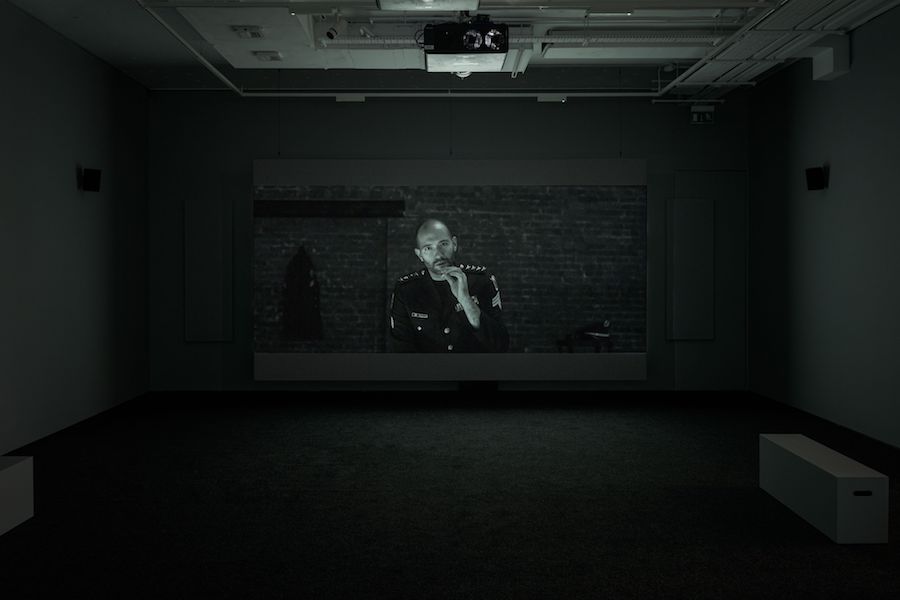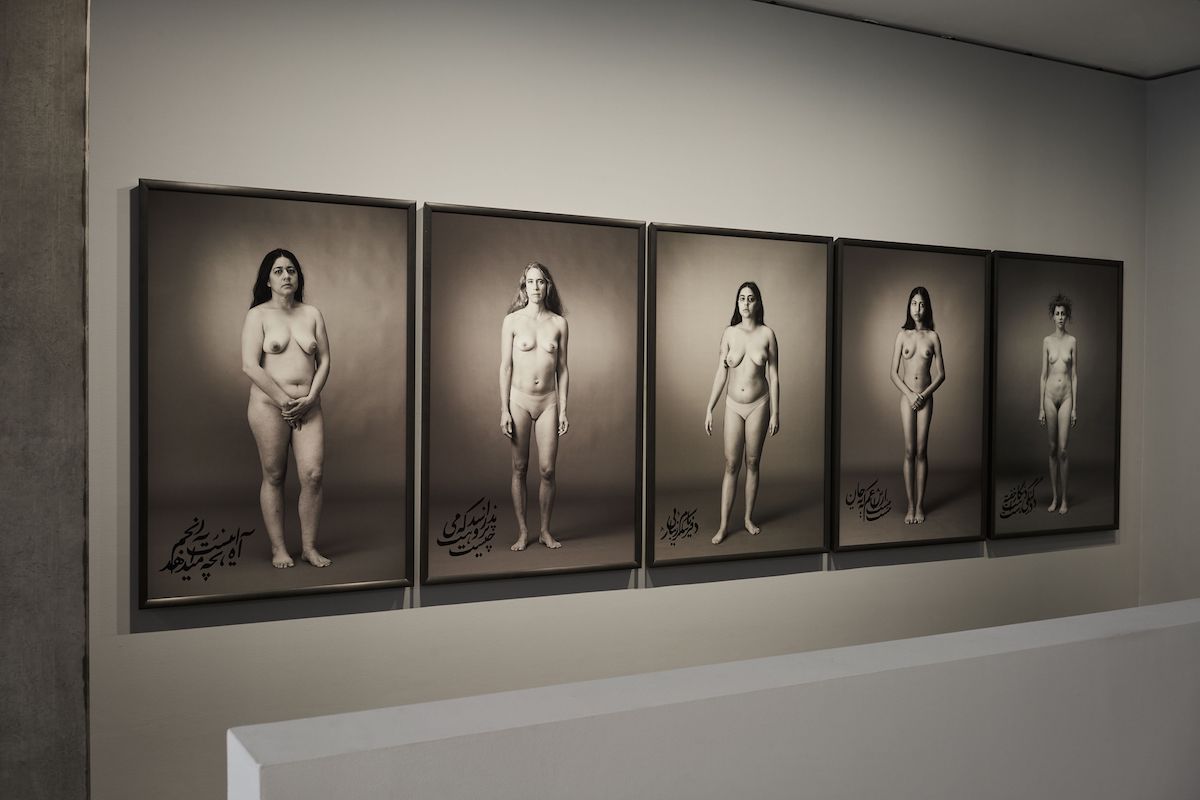I talked to New York based Iranian artist Shirin Neshat in her current show at Goodman Gallery, which presents an immersive video installation and a series of nude portraits considering the female body both as an object of desire and as an object of violence and shame. In the chilling 15-minute double-screen film work ‘The Fury’, Neshat’s protagonist dances seductively for a room of impassive soldiers. Then we see bruises on her body, indicating the abuse she has suffered, followed by her emergence onto the streets of Brooklyn. Physically displaced and mentally disturbed, she walks the streets reliving the horrors of her past. From the street’s vantage point, she is one among many in her cocoon, alienated and atomised. Yet, at the film’s conclusion, she sparks a mini-revolution as women throw trash into the air and dance wildly.
How did ‘The Fury’ come about?
For some reason, I got drawn into following the trial of the notorious prosecutor Hamid Nouri, who was captured by luck in Sweden by the international court. He was among those responsible for the massacre of nearly 3,000 young political prisoners in Iran. The victims’ families, who are now living outside, came to give testimonies. What struck me the most was how the regime would rape the young women before execution because, according to Islamic laws, virgins cannot be executed. I couldn’t stop thinking about these incredibly horrifying reports. I’ve also known several Iranian women who have spent time in prison and heard their stories about women who are sexually assaulted in prison and how they could never recover. They would often sit in a corner, wouldn’t speak, and many would commit suicide after they were freed. So, the concept of “The Fury” developed during 2021-2022, and I shot the video in June of 2022 before the Woman Life Freedom movement in Iran. In this highly fictionalised and stylised narrative, the female protagonist cannot disconnect from her haunted past and her psychological trauma, even in the state of freedom in a new country. I wanted to make a work which draws this boundary between the interior of her mind, the exterior of her mind, the interior of her apartment, the public space – and how everything was disconnected – like she wasn’t present till the end until she was most vulnerable and asked for help. So everything was created around the notions of sanity/insanity, illusion/reality, interior/exterior, Iran/USA.
And the setting is personal to you?
This video was shot where I live, in Bushwick, Brooklyn, a working-class, primarily Hispanic community. Most of the neighbourhood barely speaks English, yet these are the people I am closest to and see more than anyone else. They are my community in New York, even if we all come from different cultures and religions and speak other languages. I feel safe and at home here.
Is the woman based on an actual person?
No, she’s a fictionalised character I created and is not merely meant to represent a female political prisoner in Iran but to capture some of the trauma and dichotomies experienced universally under such conditions.

You use a double-channel video. What is the advantage of that?
This video wasn’t designed initially in two channels; I decided on that later. Everything became about creating two different points of view and putting the audience in an uncomfortable position. So, in a way, the audience becomes the editor, deciding where to look and how to put the story together. I wanted the audience to distinguish between the way she viewed the world and the way the street bystanders and the uniformed men viewed her.
She begins in a seductive manner. Why is that?
There is a development in this short narrative. First, the female protagonist appears as an object of desire through her erotic dance, and then slowly, we reveal the brutality of what has happened to her. She’s at first seductive because that’s often the story of women: we have the power to seduce and create temptation, yet due to the same reason, we can fall victim to violence. This subject is not exclusive to Iranian women, of course – I am a firm believer that most women around the globe have experienced some form of sexual assault or molestation at some point in their lives, but they don’t talk about it. We tend to internalise such experiences and even become ashamed of ourselves and our bodies.

And that’s picked up in the poems on the photographs in the show?
Yes, the poems I transcribed on the surface of the photographs are from ‘Another Birth’ by Forugh Farrokhzad, who died in 1967 at the age of 33. I have often used her poetry in my photographs. She was one of the most radical among Iranian women poets in how she expressed the problematics of the female body in relation to traditional and religious values – taboos. Her poems have often been considered blasphemous, and at some point, her books were banned in Iran. I remember one of her poems. I believe it was called ‘Face to Face with God’; she poses the question to God: if you are the creator, why am I supposed to feel so much shame about a body that you’ve given me?
Unusually for your work, both the film and the photographs feature women naked or near-naked. Why is that?
I couldn’t imagine the depiction of sexual exploitation without showing the naked flesh of a woman in “The Fury.” In the video, it was necessary for me to show both the seductive and yet brutalised body of a captured woman. In the photographs, I tried to take a similar approach. Some images resonated with notions of power, pride, dignity and beauty regardless of the women’s size and age – and in other images, we are faced with women in pain whose bodies have obviously been brutalised.

What led to how do you show the men?
The men’s gazes expressed everything: the sense of hate and violence. I didn’t need to show them doing anything to her; their bodies and uniforms represented their power and control over her. The interesting thing is that their blank expressions never changed from the time she dances seductively to when she finally fell to the floor bruised. They remained emotionless, which is so typical of men who are incapable of humanity-only atrocities. I hate to say it, but some people enjoy other people’s suffering. I’m an optimist and would like to think there is a good side to every person, but you just have to look at the last few days in the Middle East to see how hatred, violence and evil are so deeply ingrained in people. When she’s on the floor struggling, you see the men looking at her as if they enjoy it. Lastly, I was careful to make the uniforms generic and not specific to any culture.
Why is the whole show in black and white?
Initially, we shot the video in colour, but later, I changed my mind. I think there is a severity in black and white that felt right to my narrative. Also, we occasionally used Infrared with the camera, which turns everything into negative, and that was used each time we went to her point of view on the streets. Overall, I felt that the black-and-white look also helped with the melancholic mood of the story. I slowed down music – a Persian song with lyrics rewritten in Arabic – to make it more melancholic but also beautiful. That goes back to the mysticism in Iran – things are terribly sad and emotional but highly beautiful and affecting.
You made the film before Masa Amini was killed, yet there are echoes?

It’s almost uncanny how the story of “The Fury” is similar to what transpired in Iran a few months later. Here, we have a woman who becomes a victim. Her victimisation unleashes other people’s rage, which culminates in a protest, and that is exactly what happened in Iran: a revolution unravelled immediately after the murder of an innocent woman, Mahsa Amini, who became the victim of the Iranian government.
Dance is important in the film?
Yes, dance is central to the film, both as the female protagonist danced for the uniformed men and how, in the street, bystanders turned their protest into a strange ritual of dance and destruction. Oddly enough, during the Woman, Life, Freedom revolution in Iran, dance, which is forbidden in public, became an expression of protest as well.
Top Photo Shirin Neshat: The Fury – installation view, courtesy Goodman Gallery
Shirin Neshat’s ‘The Fury’ runs to 4 November at Goodman Gallery, 26 Cork Street, London W1S 3ND

